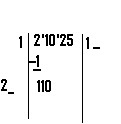Long Division Method
For finding out Square Root:
To find out Square root of a number 21025:
_____
It is denoted by √21025
Long Division Method:
_____
It is denoted by √21025
Long Division Method:
Set up a division with the number 21025 and by grouping each 2 digits of the dividend 21025 from right to left, we can rewrite as 2'10'25. Starting from 1st group from left most, which is 2, guess which square is maximum and less than or equal to 2. Because 1² is less than 2, we can choose 1 as the quotient, and divisor. Place 1 on the right side and left side. Place 1²=1 below 2. Subtract 1 from 2, the remainder is 1.
Bring down next group 10, place it after 1. Now the new dividend will become 110. Place double of the quotient which is 1x2=2 on left side as the new divisor and reserve a room right side of it and the quotient.
Now guess a new quotient which is suitable to fill in both the blanks, such that the product of the new quotient and new divisor should be maximum and less than or equal to 110. Select 4 as the new quotient and place in the blanks. Now place the product of the new divisor and new quotient is 24*4 = 96 below 110, subtract it from 110, the remainder will be 14.
Bring down the next group 25, place it after 14, then the new dividend is 1425. Now place double of the quotient means 28 on left side as new divisor and put a blank after it and the quotient 14.
We can estimate the new quotient from the formula 20*old quotient*estimate= present dividend.
20*14*estimate=1425
estimate=1425/280=5.089
So we can choose 5 as a new quotient, such that the product of 285 and 5 is maximum and less than or equal to 1425. Put 5 in both the blanks and place the product 285*5 =1425 below 1425 and subtract. The remainder is "0".
Let ab, a two digit number be the square root of a given number C.
__
√C = ab
In ab, a is in Tenth place and b is in Units place.
__
√C = ab
In ab, a is in Tenth place and b is in Units place.
The value of "ab" is 10 times a, plus b. ie.10*a + b.
__
√C = 10*a + b
Squaring both sides
C = (10*a + b)²
C =100* a²+ b²+20*a*b
C-100*a² = b² + 20*a*b
rewriting the above
rewriting the above
C-100*a² = (20*a + b)*b
LHS =C-100*a² is nothing but the remainder after performing with initial quotient a.
RHS=b*(b+20*a) is nothing but the product of new quotient b and new divisor (20*a + b).
Here 20*a + b means double of a in Tenths place and b in Units place which can be denoted by (2*a)b
In the above example a=1 and b=4, so 20*a +b=24 which is nothing but 4 placed after the double of 1.
And in the next step, a=14 and b=5, so 20*a +b=285 which is nothing but 5 placed after double of 14.
Like this in each operation, we have to choose a new quotient b, such that product of new divisor(20*a +b) and new quotient (b) should be maximum and less than or equal to the new dividend.






Nice
ReplyDelete